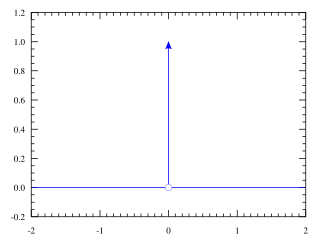Discrete measure – Wikipedia
From Wikipedia, the free encyclopedia

In mathematics, more precisely in measure theory, a measure on the real line is called a discrete measure (in respect to the Lebesgue measure) if it is concentrated on an at most countable set. The support need not be a discrete set. Geometrically, a discrete measure (on the real line, with respect to Lebesgue measure) is a collection of point masses.
Definition and properties[edit]
A measure
defined on the Lebesgue measurable sets of the real line with values in
is said to be discrete if there exists a (possibly finite) sequence of numbers
such that
The simplest example of a discrete measure on the real line is the Dirac delta function
One has
and
More generally, if
is a (possibly finite) sequence of real numbers,
is a sequence of numbers in
of the same length, one can consider the Dirac measures
defined by
for any Lebesgue measurable set
Then, the measure
is a discrete measure. In fact, one may prove that any discrete measure on the real line has this form for appropriately chosen sequences
and
Extensions[edit]
One may extend the notion of discrete measures to more general measure spaces. Given a measurable space
and two measures
and
on it,
is said to be discrete in respect to
if there exists an at most countable subset
of
such that
- All singletons with are measurable (which implies that any subset of is measurable)
Notice that the first two requirements are always satisfied for an at most countable subset of the real line if
is the Lebesgue measure, so they were not necessary in the first definition above.
As in the case of measures on the real line, a measure
on
is discrete in respect to another measure
on the same space if and only if
has the form
where
the singletons
are in
and their
measure is 0.
One can also define the concept of discreteness for signed measures. Then, instead of conditions 2 and 3 above one should ask that
be zero on all measurable subsets of
and
be zero on measurable subsets of
References[edit]
- Kurbatov, V. G. (1999). Functional differential operators and equations. Kluwer Academic Publishers. ISBN 0-7923-5624-1.
External links[edit]
 defined on the Lebesgue measurable sets of the real line with values in
defined on the Lebesgue measurable sets of the real line with values in ![[0,infty ]](https://wikimedia.org/api/rest_v1/media/math/render/svg/52088d5605716e18068a460dec118214954a68e9) is said to be discrete if there exists a (possibly finite) sequence of numbers
is said to be discrete if there exists a (possibly finite) sequence of numbers


 One has
One has  and
and 
 is a (possibly finite) sequence of real numbers,
is a (possibly finite) sequence of real numbers,  is a sequence of numbers in
is a sequence of numbers in  defined by
defined by

 Then, the measure
Then, the measure

 and two measures
and two measures  on it,
on it,  of
of  such that
such that




 is discrete in respect to another measure
is discrete in respect to another measure  the singletons
the singletons  are in
are in  and their
and their 
Recent Comments